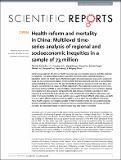Files in this item
Health reform and mortality in China : multilevel time-series analysis of regional and socioeconomic inequities in a sample of 73 million
Item metadata
| dc.contributor.author | Astell-Burt, Thomas Edward | |
| dc.contributor.author | Liu, Yunning | |
| dc.contributor.author | Feng, Xiaoqi | |
| dc.contributor.author | Yin, Peng | |
| dc.contributor.author | Page, Andrew | |
| dc.contributor.author | Liu, Shiwei | |
| dc.contributor.author | Liu, Jiangmei | |
| dc.contributor.author | Wang, Lijun | |
| dc.contributor.author | Zhou, Maigeng | |
| dc.date.accessioned | 2015-11-03T09:40:03Z | |
| dc.date.available | 2015-11-03T09:40:03Z | |
| dc.date.issued | 2015-10-15 | |
| dc.identifier | 228178565 | |
| dc.identifier | b9119033-ef30-4e06-b9e6-6d2cbf9991ca | |
| dc.identifier | 000362811700002 | |
| dc.identifier | 84945218439 | |
| dc.identifier | 000362811700002 | |
| dc.identifier.citation | Astell-Burt , T E , Liu , Y , Feng , X , Yin , P , Page , A , Liu , S , Liu , J , Wang , L & Zhou , M 2015 , ' Health reform and mortality in China : multilevel time-series analysis of regional and socioeconomic inequities in a sample of 73 million ' , Scientific Reports , vol. 5 , 15038 . https://doi.org/10.1038/srep15038 | en |
| dc.identifier.issn | 2045-2322 | |
| dc.identifier.uri | https://hdl.handle.net/10023/7730 | |
| dc.description | This study was funded by the China National Science & Technology Pillar Program 2013 (2013BAI04B02) from the Ministry of Science and Technology. Funding was also received from the Australia China Science and Research Fund. Thomas Astell-Burt is supported by a National Heart Foundation of Australia Postdoctoral Fellowship (#100161). | en |
| dc.description.abstract | China's 2009 expansion of universal health insurance has received global interest, but little empirical investigation. This epidemiological study was a first attempt to assess potential impacts on population health and health equity. Multilevel negative binomial regression was used to analyse all-cause and non-communicable disease (NCD) mortality between 2006 and 2012 from a representative sample including all 31 provinces. The age-standardised ratios (per 100,000) in 2006 were 860.4 and 732.9 for mortality from all-causes and NCDs respectively. These ratios decreased over time to 737.5 (all-causes) and 642.9 (NCD) by 2012. Modelling indicated these trajectories were curvilinear, dipping more rapidly from 2009 onwards. Compared to the east, all-cause mortality was higher in other regions (e.g. northwest RR: 1.34, 95% CI: 1.20, 1.48). Compared to more affluent urban areas, rate ratios for all-cause mortality were 1.23 (95% CI: 0.97, 1.54) in the least affluent urban areas, 1.22 (95% CI: 1.02, 1.46) in affluent rural areas and 1.64 (95% CI: 1.51, 1.79) in the least affluent rural areas. These health inequities were largely repeated for NCD mortality and did not vary spatiotemporally. Overall, universal health insurance in China may have accelerated reductions in all-cause and NCD mortality, but potential impacts on health inequity may take longer to manifest. | |
| dc.format.extent | 5 | |
| dc.format.extent | 303536 | |
| dc.language.iso | eng | |
| dc.relation.ispartof | Scientific Reports | en |
| dc.subject | Universal health | en |
| dc.subject | Care | en |
| dc.subject | RA0421 Public health. Hygiene. Preventive Medicine | en |
| dc.subject | 3rd-NDAS | en |
| dc.subject | SDG 3 - Good Health and Well-being | en |
| dc.subject.lcc | RA0421 | en |
| dc.title | Health reform and mortality in China : multilevel time-series analysis of regional and socioeconomic inequities in a sample of 73 million | en |
| dc.type | Journal article | en |
| dc.contributor.institution | University of St Andrews. School of Geography and Geosciences | en |
| dc.identifier.doi | 10.1038/srep15038 | |
| dc.description.status | Peer reviewed | en |
This item appears in the following Collection(s)
Items in the St Andrews Research Repository are protected by copyright, with all rights reserved, unless otherwise indicated.

